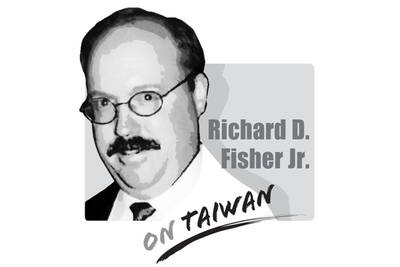A few days before this year’s Double Ten National Day celebration, former president Ma Ying-jeou (馬英九) said he would not attend the official ceremony because he did not want his presence to be viewed as “an endorsement of Taiwanese independence.”
Yet on the day of the celebration in front of the Presidential Office Building, the words on the banners read: “The 112th National Day of the Republic of China,” not Taiwan.
President Tsai Ing-wen (蔡英文), who was elected by the citizens of the Republic of China (ROC), made a speech at the podium. Taiwanese heroes and students performed the national anthem of the ROC. The ROC Air Force showed off its achievements in locally designed and produced jet trainers, the AT-5 Yung Ying (“Brave Eagle”), arranging for the aircraft to fly over the Presidential Office Building. A military honor guard also performed.
In her address, Tsai said that over the past seven years, all Taiwanese have contributed to building a highly resilient economy. Taiwan’s economy has become a key force in the restructuring of global supply chains. As a result, the ROC has become stronger. She also expressed her gratitude to Taiwanese for giving her two terms as president of the ROC.
During the ceremony, “the strength of the ROC” and “the president of the ROC” were mentioned several times. It was nothing but a celebration of the ROC’s national day.
On the other hand, the site of the old Presidential Palace in Nanjing, China, that Ma visited in March is an empty shell. That “Republic of China” was already eliminated by the People’s Republic of China (PRC). Ma could have voiced his disapproval, yet he remained silent.
A nation’s development should follow international trends. The “anti-China” trend of today came into being after countries around the world began seeing China as a threat.
In addition to Taiwan’s own freedom and democracy, as well as its capability in technology, it has been following this trend, and therefore gains support from other democracies.
For example, the US Congress has passed a bill to defend Taiwan’s international status, saying that UN Resolution 2758 (which recognizes the PRC as the sole legitimate government of China) does not apply to Taiwan.
In terms of its economy, Taiwan was not overly affected by the COVID-19 pandemic. Instead, the economy has grown further thanks to the government’s issuance of stimulus vouchers and cash, and the introduction of the TPass monthly mass public transportation program. Rental subsidies were also provided to help people in a practical way. These are the fruits of the joint efforts of Taiwanese.
All the above are built upon the autonomous political institutions and economic system of the ROC in Taiwan.
Taiwanese agree with Tsai’s “four commitments.” The commitment emphasizing that the ROC and the PRC should not be subordinate to each other has clearly defined that Taiwan and China are two separate national entities. The issue has never been a domestic one.
The ROC exists on Taiwanese soil and its outlying islands. Along with the changing international situation, the ROC has developed into a country different from the one that claimed 35 provinces across the Taiwan Strait. The people of the ROC have been growing and thriving in Taiwan. This is the reality. As a reserve lieutenant commander, I disagree with Ma’s reasoning for not attending the official Double Ten National Day ceremony.
Arthur Chang is a navy reserve lieutenant commander.
Translated by Emma Liu

On Sept. 3 in Tiananmen Square, the Chinese Communist Party (CCP) and the People’s Liberation Army (PLA) rolled out a parade of new weapons in PLA service that threaten Taiwan — some of that Taiwan is addressing with added and new military investments and some of which it cannot, having to rely on the initiative of allies like the United States. The CCP’s goal of replacing US leadership on the global stage was advanced by the military parade, but also by China hosting in Tianjin an August 31-Sept. 1 summit of the Shanghai Cooperation Organization (SCO), which since 2001 has specialized
In an article published by the Harvard Kennedy School, renowned historian of modern China Rana Mitter used a structured question-and-answer format to deepen the understanding of the relationship between Taiwan and China. Mitter highlights the differences between the repressive and authoritarian People’s Republic of China and the vibrant democracy that exists in Taiwan, saying that Taiwan and China “have had an interconnected relationship that has been both close and contentious at times.” However, his description of the history — before and after 1945 — contains significant flaws. First, he writes that “Taiwan was always broadly regarded by the imperial dynasties of
The Chinese Communist Party (CCP) will stop at nothing to weaken Taiwan’s sovereignty, going as far as to create complete falsehoods. That the People’s Republic of China (PRC) has never ruled Taiwan is an objective fact. To refute this, Beijing has tried to assert “jurisdiction” over Taiwan, pointing to its military exercises around the nation as “proof.” That is an outright lie: If the PRC had jurisdiction over Taiwan, it could simply have issued decrees. Instead, it needs to perform a show of force around the nation to demonstrate its fantasy. Its actions prove the exact opposite of its assertions. A
A large part of the discourse about Taiwan as a sovereign, independent nation has centered on conventions of international law and international agreements between outside powers — such as between the US, UK, Russia, the Republic of China (ROC) and Japan at the end of World War II, and between the US and the People’s Republic of China (PRC) since recognition of the PRC as the sole representative of China at the UN. Internationally, the narrative on the PRC and Taiwan has changed considerably since the days of the first term of former president Chen Shui-bian (陳水扁) of the Democratic